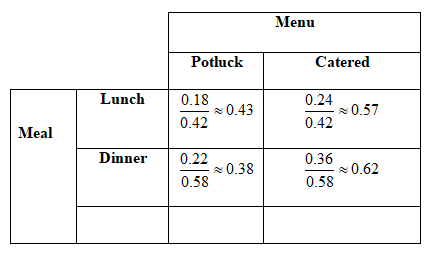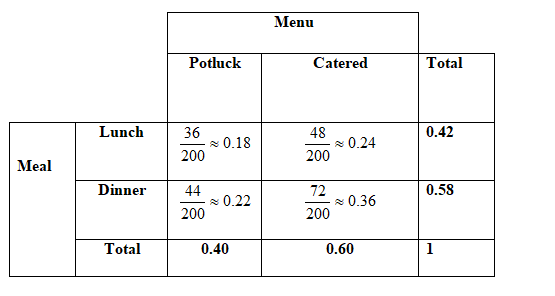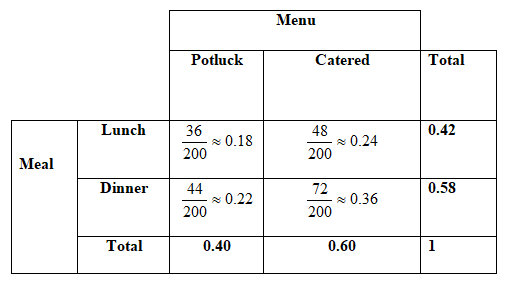
To make a two-way table with conditional relative frequencies based on row totals and the conditional relative frequency that shows the employees prefers a lunch event that is catered.
Answer to Problem 23E
This is the correct two-way table with joint relative frequencies.

The conditional relative frequency that the employee prefers a catered event during lunch is 0.57
Explanation of Solution
Given information:
The information provided in the two-way table.
Formula Used:
Joint relative frequencies are found out by dividing each joint frequency by the total number of observations in the two-way table.
Sum up the rows of the joint relative frequencies in order to arrive at the marginal relative frequencies.
Divide the joint relative frequencies with the marginal relative frequencies to get the resulting two-way table.
Total number of observations is
Hence the correct table of joint relative frequencies is
For instance, the joint relative frequency of potluck being preferred in lunch is
The correct calculation is

Next, divide the joint relative frequencies by the marginal relative frequencies on the row totals.

Thus, the conditional relative frequency that the employee prefers a catered event during lunch is 0.57
Chapter 11 Solutions
BIG IDEAS MATH Integrated Math 1: Student Edition 2016
- Let y(t) represent your retirement account balance, in dollars, after t years. Each year the account earns 7% interest, and you deposit 8% of your annual income. Your current annual income is $34000, but it is growing at a continuous rate of 2% per year. Write the differential equation modeling this situation. dy dtarrow_forwardDetermine Whether series converge or diverge if it converge what is the limit. $\{ \frac {(-1)^{n-2}n^{2}}{4+n^{3}}\} _{n=0}^{\infty }$arrow_forwardLet y(t) represent your retirement account balance, in dollars, after t years. Each year the account earns 7% interest, and you deposit 8% of your annual income. Your current annual income is $34000, but it is growing at a continuous rate of 2% per year. Write the differential equation modeling this situation. dy dtarrow_forward
- 8:37 ▬▬▬▬▬▬▬▬▬ Ο Graph of f The figure shows the graph of a periodic function f in the xy-plane. What is the frequency of f? 0.5 B 2 C 3 D 8 3 of 6 ^ Oli Back Next apclassroom.collegeboard.orgarrow_forward2. The growth of bacteria in food products makes it necessary to time-date some products (such as milk) so that they will be sold and consumed before the bacteria count is too high. Suppose for a certain product that the number of bacteria present is given by f(t)=5000.1 Under certain storage conditions, where t is time in days after packing of the product and the value of f(t) is in millions. The solution to word problems should always be given in a complete sentence, with appropriate units, in the context of the problem. (a) If the product cannot be safely eaten after the bacteria count reaches 3000 million, how long will this take? (b) If t=0 corresponds to January 1, what date should be placed on the product?arrow_forward2.6 Applications: Growth and Decay; Mathematics of Finances 1. A couple wants to have $50,000 in 5 years for a down payment on a new house. (a) How much should they deposit today, at 6.2% compounded quarterly, to have the required amount in 5 years? (b) How much interest will be earned? (c) If they can deposit only $30,000 now, how much more will they need to complete the $50,000 after 5 years? Note, this is not 50,000-P3.arrow_forward
 Discrete Mathematics and Its Applications ( 8th I...MathISBN:9781259676512Author:Kenneth H RosenPublisher:McGraw-Hill Education
Discrete Mathematics and Its Applications ( 8th I...MathISBN:9781259676512Author:Kenneth H RosenPublisher:McGraw-Hill Education Mathematics for Elementary Teachers with Activiti...MathISBN:9780134392790Author:Beckmann, SybillaPublisher:PEARSON
Mathematics for Elementary Teachers with Activiti...MathISBN:9780134392790Author:Beckmann, SybillaPublisher:PEARSON
 Thinking Mathematically (7th Edition)MathISBN:9780134683713Author:Robert F. BlitzerPublisher:PEARSON
Thinking Mathematically (7th Edition)MathISBN:9780134683713Author:Robert F. BlitzerPublisher:PEARSON Discrete Mathematics With ApplicationsMathISBN:9781337694193Author:EPP, Susanna S.Publisher:Cengage Learning,
Discrete Mathematics With ApplicationsMathISBN:9781337694193Author:EPP, Susanna S.Publisher:Cengage Learning, Pathways To Math Literacy (looseleaf)MathISBN:9781259985607Author:David Sobecki Professor, Brian A. MercerPublisher:McGraw-Hill Education
Pathways To Math Literacy (looseleaf)MathISBN:9781259985607Author:David Sobecki Professor, Brian A. MercerPublisher:McGraw-Hill Education





